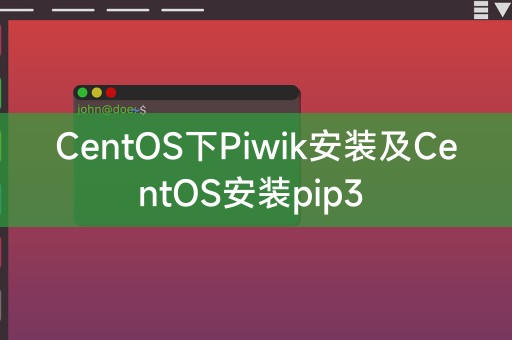Home >System Tutorial >LINUX >Piwik installation under CentOS and pip3 installation on CentOS
Piwik installation under CentOS and pip3 installation on CentOS
- PHPzforward
- 2024-02-09 12:48:36628browse
php editor Xigua brings you a tutorial on installing Piwik under CentOS and installing pip3 on CentOS. In this tutorial, we will introduce in detail how to install Piwik on CentOS system, which is a powerful open source website analysis tool. At the same time, we will also teach you how to install pip3 in CentOS system, which is a package management tool for Python, making it convenient for you to install and manage Python third-party libraries. If you are interested in Piwik installation and pip3 installation on CentOS systems, then this tutorial is definitely not to be missed!

Piwik installation under CentOS
1. Download Piwik
We need to download the Piwik software package, you can download the latest through the official website () version of Piwik.
2. Install the LAMP environment
Before installing Piwik, we need to install the LAMP environment (Linux Apache MySQL PHP). You can install the LAMP environment through the following command:
` ``
sudo yum install httpd
sudo systemctl start httpd
sudo systemctl enable httpd
sudo yum install mariadb-server
sudo systemctl start mariadb
sudo systemctl enable mariadb
sudo yum install php php-mysql
sudo systemctl restart httpd
3. Create database
Before installing Piwik, we need to create a database to store Piwik data. You can create the database through the following command:
mysql -u root -p
CREATE DATABASE piwik;
CREATE USER 'piwikuser'@'localhost' IDENTIFIED BY 'password';
GRANT ALL PRIVILEGES ON piwik.* TO 'piwikuser'@'localhost';
FLUSH PRIVILEGES;
EXIT;
4. Install Piwik
Unzip the Piwik package and place it in the Apache website root directory (usually /var/www/html) , you can use the following command to install:
sudo tar -zxvf piwik-x.x.x.tar.gz -C /var/www/html/
5. Configure Piwik
Edit Piwik's configuration file, fill in the database-related information into the configuration file:
sudo nano /var/www/html/piwik/config/config.ini.php
Modify the following lines:
[database]
host = "localhost"
username = "piwikuser"
password = "password"
dbname = " piwik"
Save and exit the configuration file.
6. Complete the installation
Enter the IP address or domain name of the server in the browser, and then follow the prompts of the installation wizard to complete the installation of Piwik.
CentOS installation pip3
1. Install EPEL repository
pip3 is a Python package management tool. You need to install the EPEL repository before you can install pip3. You can use the following command to install EPEL Warehouse:
sudo yum install epel-release
2. Install pip3
After installing the EPEL warehouse, you can use the following command to install pip3:
sudo yum install python3-pip
3. Verify the installation
After the installation is complete, you can use the following command to verify whether pip3 is successfully installed:
pip3 --version
If the installation is successful, the version information of pip3 will be displayed.
Share for you
In CentOS system, installing Piwik can help you track and analyze the activities of users who visit your website, thereby optimizing your website and improving user experience, while installing pip3 can Conveniently manage Python packages, I hope this article will be helpful to you!
The above is the detailed content of Piwik installation under CentOS and pip3 installation on CentOS. For more information, please follow other related articles on the PHP Chinese website!

